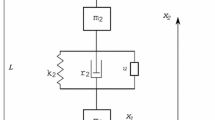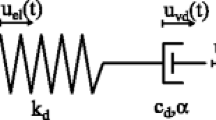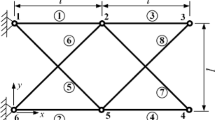Abstract
The existing direct sensitivity analysis of optimal structural vibration control based on Lyapunov’s second method is computationally expensive when applied to finite element models with a large number of degree-of-freedom and design variables. A new adjoint sensitivity analysis method is proposed in this paper. Using the new method the sensitivity of the performance index, a time integral of a quadratic function of state variables, with respect to all design variables is calculated by solving two Lyapunov matrix equations. In consideration of computational cost reduction, the new adjoint method is further extended to the reduced order model by Guyan method. This makes the method applicable to large finite element models. Two numerical examples demonstrate the accuracy and efficiency of the proposed method.









Similar content being viewed by others
References
Asami T, Nishihara O, Baz AM (2002) Analytical solutions to H∞ and H2 optimization of dynamic vibration absorbers attached to damped linear systems. J Vib Acoust 124(2):284–295
Bendsoe MP, Sigmund O (2003) Topology optimization: theory, methods and applications. Springer, Berlin, Heidelberg
Díaaz AR, Kikuchi N (1992) Solutions to shape and topology eigenvalue optimization problems using a homogenization method. Int J Numer Methods Eng 35(7):1487–1502
Du D (2008) Analytical solutions for DVA optimization based on the lyapunov equation. J Vib Acoust 130(5):054501
Guyan RJ (1965) Reduction of stiffness and mass matrices. AIAA J 3(2):380–380
Housner GW, Bergman L, Caughey TK et al (1997) Structural control: past, present, and future. J Eng Mech 123(9):897–971
Irons B (1965) Structural eigenvalue problems—elimination of unwanted variables. AIAA J 3(5):961–962
Jensen JS, Nakshatrala PB, Tortorelli DA (2014) On the consistency of adjoint sensitivity analysis for structural optimization of linear dynamic problems. Struct Multidiscip Optim 49(5):831–837
Kalman RE, Bertram JE (1960) Control system analysis and design Via the “second method” of lyapunov: I—continuous-time systems. J Fluids Eng 82(2):371–393
Kang Z, Wang X, Wang R (2009) Topology optimization of space vehicle structures considering attitude control effort. Finite Elem Anal Des 45:431–438
Korenev BG, Reznikov LM (1993) Dynamic vibration absorbers: theory and technical applications. Wiley, Chichester
Marano GC, Greco R, Trentadue F, Chiaia B (2007) Constrained reliability-based optimization of linear tuned mass dampers for seismic control. Int J Solids Struct 44(22):7370–7388
Marano GC, Greco R, Chiaia B (2010) A comparison between different optimization criteria for tuned mass dampers design. J Sound Vib 329(23):4880–4890
Mead DJ, Meador DJ (1998) Passive vibration control. Wiley, Chichester
Molter A, da Silveira OA, Bottega V, Fonseca JS (2013) Integrated topology optimization and optimal control for vibration suppression in structural design. Struct Multidiscip Optim 47(3):389–397
Ogata K, Yang Y (1970) Modern control engineering
Ozer MB, Royston TJ (2005) Extending Den Hartog’s vibration absorber technique to multi-degree-of-freedom systems. J Vib Acoust 127(4):341–350
Pennestrı E (1998) An application of Chebyshev's min–max criterion to the optimal design of a damped dynamic vibration absorber. J Sound Vib 217(4):757–765
Preumont A (1997) Vibration control of active structures. Kluwer academic publishers, Dordrecht
Rüdinger F (2006) Optimal vibration absorber with nonlinear viscous power law dam** and white noise excitation. J Eng Mech 132(1):46–53
Van Keulen F, Haftka RT, Kim NH (2005) Review of options for structural design sensitivity analysis. Part 1: linear systems. Comput Methods Appl Mech Eng 194(30):3213–3243
Wang BP, Kitis L, Pilkey WD (1984) Transient response optimization of vibrating structures by Liapunov’s second method. J Sound Vib 96:505–512
Wang W, Cheng GD, Li QH (2013) Fast dynamic performance optimization of complicated beam-type structures based on two new reduced physical models. Eng Optim 45(7):835–850
Zhang X, Kang Z (2013) Topology optimization of dam** layers for minimizing sound radiation of shell structures. J Sound Vibration 332:2500–2519
Acknowledgment
This work is supported by National Natural Science Foundation of China (91216201 and 11372062).
Author information
Authors and Affiliations
Corresponding author
Appendix A Adjoint sensitivity analysis for the reduced model by Guyan reduction
Appendix A Adjoint sensitivity analysis for the reduced model by Guyan reduction
The derivative of objective function with respect to design parameters can be expressed as (42)
where, \( \frac{\partial {\mathbf{X}}_{re}(0)}{\partial {d}_k}={\left(\begin{array}{cc}\hfill \frac{\partial {\mathbf{u}}_{re,0}^T}{\partial {d}_k}\hfill & \hfill \frac{\partial {\mathbf{v}}_{re,0}^T}{\partial {d}_k}\hfill \end{array}\right)}^T \). From the (37), we get that
T cannot be inverted directly, so premultiply both sides of the equation by matrix T T M. Then, we get
Then
In (42), the item \( {\mathbf{X}}_{re}^T(0)\frac{\partial {\mathbf{P}}_{re}}{\partial {d}_k}{\mathbf{X}}_{re}(0) \) can be obtained by adjoint method mentioned in section 3.2.
where M is number of DOFs in reduced model, \( {\mathbf{D}}^{re,k}=\frac{\partial {\mathbf{A}}_{re}^T}{\partial {d}_k}{\mathbf{P}}_{re}+{\mathbf{P}}_{re}\frac{\partial {\mathbf{A}}_{re}}{\partial {d}_k}+\frac{\partial {\mathbf{Q}}_{re}}{\partial {d}_k} \). Letting
λ re can be obtained by solving one Lyapunov matrix equation
\( \frac{\partial {\mathbf{A}}_{re}}{\partial {d}_k} \) can be expressed as
where
\( \frac{\partial {\mathbf{M}}_{\mathrm{re}}^{-1}}{\partial {d}_k} \) can be obtained by
where
The matrix \( \frac{\partial {\mathbf{Q}}_{re}}{\partial {d}_k} \) can be expressed as
And now, it remains to derive the solution of \( \frac{\partial \mathbf{T}}{\partial {d}_k} \) in terms of sensitivities of stiffness matrix. From (34), \( \frac{\partial \mathbf{T}}{\partial {d}_k} \) can be expressed as
where
Note that \( \frac{\partial {\mathbf{K}}_{ss}}{\partial {d}_k} \) and \( \frac{\partial {\mathbf{K}}_{sm}}{\partial {d}_k} \) are part of \( \frac{\partial \mathbf{K}}{\partial {d}_k} \). For the case the design variable is dum** coefficient of the dumped spring, \( \frac{\partial {\mathbf{K}}_{ss}}{\partial {d}_k} \) and \( \frac{\partial {\mathbf{K}}_{sm}}{\partial {d}_k} \) is zero, the computational cost can be further reduced.
Rights and permissions
About this article
Cite this article
Yan, K., Cheng, G. & Wang, B.P. Adjoint methods of sensitivity analysis for Lyapunov equation. Struct Multidisc Optim 53, 225–237 (2016). https://doi.org/10.1007/s00158-015-1323-z
Received:
Revised:
Accepted:
Published:
Issue Date:
DOI: https://doi.org/10.1007/s00158-015-1323-z




